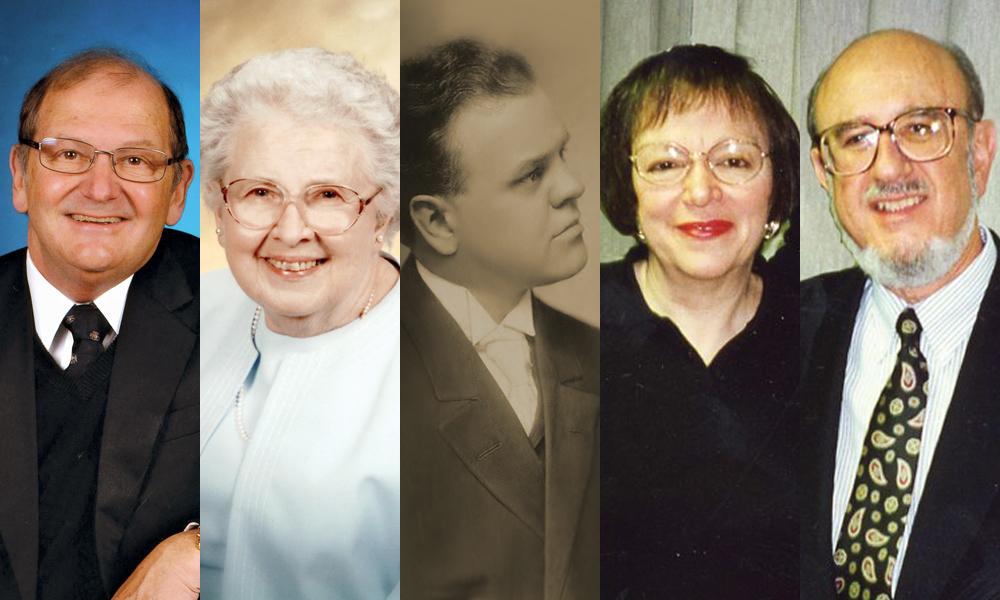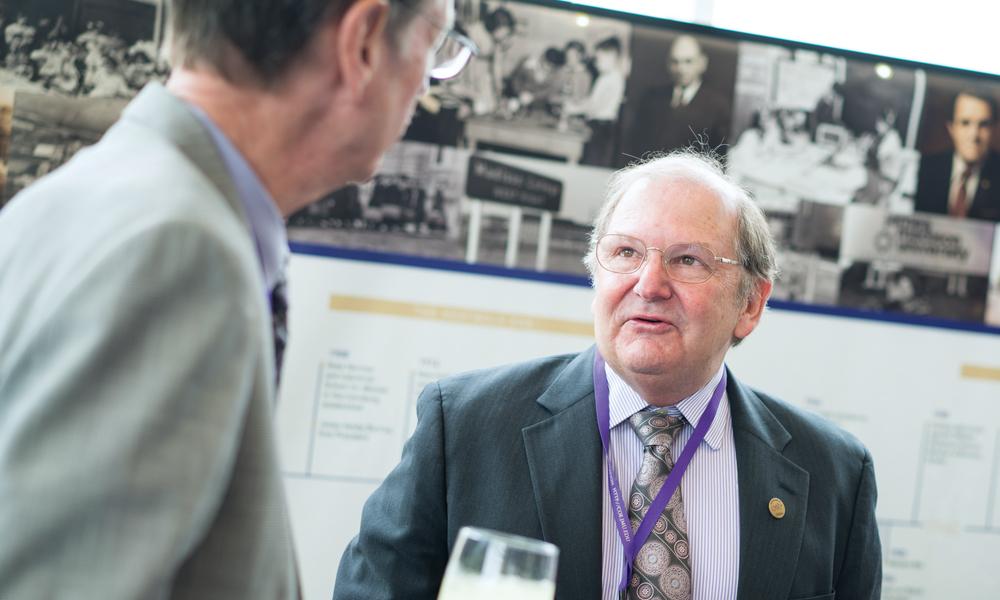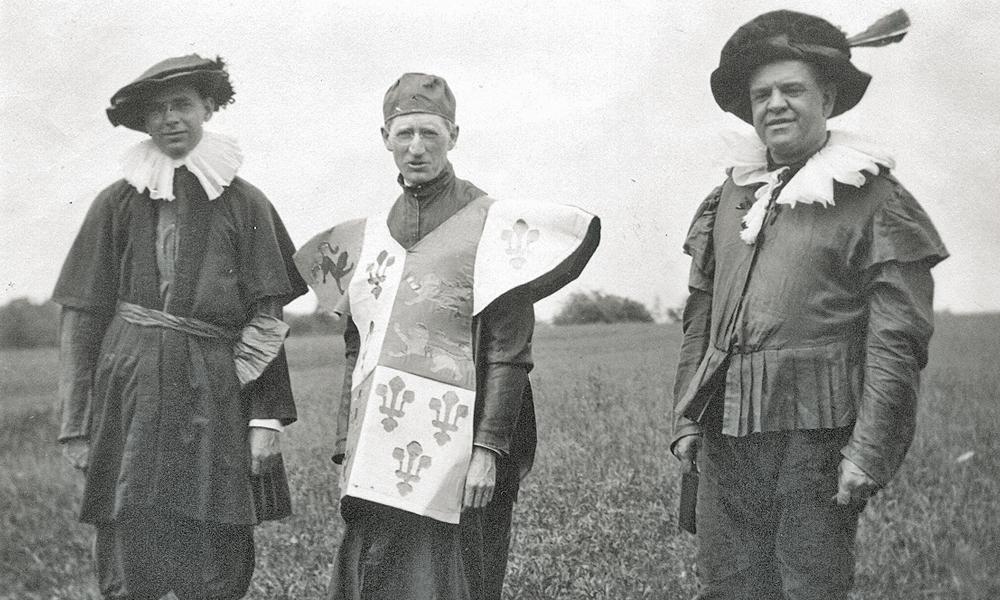On the shoulders of giants
College of Education Hall of Distinction inducts first class
Education
SUMMARY: Educational giants Phil Bigler, Mildred Dickerson, Cornelius Heatwole, Esther Minskoff and J. Gerald Minskoff are inducted into the College of Education's new Hall of Distinction in recognition of their unique contributions to JMU and the education profession.
From Fall 2017 Madison
When Mildred Dickerson, beloved teacher of young children as well as early childhood education students at Madison, died in 2009, Phillip Wishon, dean of the College of Education, started thinking about an appropriate way to honor her life.
“JMU already had a scholarship in her name and her husband’s name—The Dr. and Mrs. Z.S. Dickerson Endowed Scholarship,” Wishon recalls. “I was thinking of her contributions to who we are as a college and realized that we’re standing on the shoulders of these giants who came before us.”
After several years of discussions, Wishon decided the time was right to develop guidelines and procedures for establishing the JMU College of Education Hall of Distinction. And on May 21, five of the university’s educational giants were inducted into the hall to honor their contributions to JMU and the education profession.
Informational banners and a display case of photographs and memorabilia spotlighting the contributions of Dickerson, Phil Bigler, Cornelius Heatwole and Esther and Jerry Minskoff are displayed on the first floor of Memorial Hall. Additional information and photographs of the educators are available on the hall’s website at College of Education.
More educators will be added to the hall, but not necessarily annually, Wishon says. “We want the hall to expand as we become aware of others worthy of recognition.”
Phil Bigler
National Teacher of the Year, historian, professor, book author, publisher, voracious reader and lifelong student.
Phil Bigler (’74, ’76M) has filled all of these roles in a career spanning 40 years in public-school classrooms and beyond, including serving as director of JMU’s James Madison Center for nine years and Arlington National Cemetery’s historian during the 40th anniversary of World War II.
Bigler transferred to Madison College as a junior in 1972 after attending Virginia Tech and George Mason University. His first inkling of how student-centered his new school was came in the form of a welcoming phone call from Raymond Dingledine, who was head of the history department. Classes with history’s Lee Congdon and Clive Hallman and education’s Norman Lyon and Harold Lehman helped develop Bigler’s already keen interest in history to prepare him for his own classroom.
“I came out with a great education,” says Bigler, who left JMU with a master’s in education and a Bachelor of Arts degree in history. “I had a solid history background and I enjoyed wonderful interactions with my JMU professors in history and education.”
He joined Fairfax County Public Schools, where he taught 22 different courses in his 23-year public high-school teaching career, including classes in American history—his favorites—Russian history, economics and Middle Eastern history. “Every time I taught a new class, it was a new sense of discovery,” Bigler says.
That suited him fine. “My job was reading and learning,” Bigler says. “I loved history so much I wanted to share it. I wanted to show young people how important history is to their lives.”
He initially tried to mimic his own instructors by lecturing, but found he needed new, more active methods to bring history alive for his high-school students.
|
I have always seen my role as a teacher to facilitate student learning in what will be their lifelong quest for knowledge, to help ignite in students the spark of enlightenment, to motivate their interest, and to cultivate their minds. Phil Bigler |
He turned to using simulations to immerse his students in specific historical periods. A perennial favorite simulation was of the 1960 Kennedy-Nixon presidential election campaign. Using technology available at the time—a commercially produced computer game—Bigler developed lesson plans and guided his students as they learned about the election and the Electoral College. Students held mock presidential debates, wrote position papers and campaign literature, created posters and made speeches to demonstrate their understanding of the campaign’s issues.
Writing about the simulation’s mythical election-night atmosphere in his 2012 book Teaching History in an Uncivilized World, Bigler says: “The tension in the classroom was palpable as everyone anxiously awaited the returns. As each state finally projected, often late into the simulated evening, the students would either shout with delight or cry in anguish. Other teachers on our hallway would often look out of their classroom doors, perplexed by the commotion, but what they were actually witnessing was authentic, content-rich learning.”
Such engagement earned Bigler honors as Most Influential Teacher at McLean High School as voted by the senior classes of 1995 and 1996 and later Teacher of the Year for MHS, Fairfax County, Virginia, and ultimately National Teacher of the Year in 1998. From a White House Rose Garden ceremony with President Bill Clinton to a whirlwind year of speaking engagements as the nation’s top teacher, Bigler used his position to spotlight the need for support of public education and the importance of studying history.
“Every age goes through its own unique challenges,” Bigler says. “But looking at the turmoil throughout history, we can gain a better perspective on our own time.”
He also views teachers as people with great responsibility beyond their content areas. “Quite frankly, for six and a half or seven hours [per day], you may be the only positive influence on a student’s life,” he says. “You need to be an exemplary person for students to look up to.”

Now retired from the classroom, Bigler remains committed to education. He is editor and president of Apple Ridge Publishers, a company that focuses on education and history-related materials. He remains involved with the Virginia Teacher of the Year network and the Virginia Teachers of Promise Institute, and he likes what he sees in the next generation of educators.
“The students and young teachers are every bit as good as we were,” he says.
“This is one of the most exciting times to be an educator because of the technology and the ability to do things that were unheard of 30, 40 years ago,” Bigler says. “One of my emphases has been that teachers need to change and always have. I was a much better teacher later in my career.”
Mildred Dickerson
“She put teacher education on the map,” says Dean Wishon. “She was one of the most distinguished early-childhood professionals in the nation during her time here.”
Dickerson, who joined the Madison College faculty in 1958, established the nursery school in the newly developed Anthony-Seeger Campus School. In concert with that role, she taught classes for the Madison College education students who were observing and working with preschool children.
Her expertise in early-childhood education was invaluable to Madison’s future teachers when Virginia mandated public kindergarten in 1965. Named coordinator of the early-childhood education program, Dickerson developed the undergraduate and master’s programs of study.
She also served the education profession as president of the Southern Early Childhood Association from 1984 to 1985 and earlier as president of the Virginia Association for Early Childhood Education.
Dickerson led the effort to establish what is now the Harrisonburg-Rockingham Child Day Care Center. For her dedication to teaching thousands of young pupils and college students, Dickerson received the VAECE Award for Outstanding Service to Young Children. She retired from JMU in 1986.
Cornelius Heatwole
“Dr. Heatwole was the first head of teacher education here,” Wishon says. “He established an organizational structure, an administrative structure, a conceptual framework that launched us as a normal school.”
As president of the newly established State Normal and Industrial School for Women at Harrisonburg, Julian Burruss recommended that Heatwole, who was born and raised in nearby Dale Enterprise, be named to head the school’s foundational education department. A graduate of Peabody College and Columbia University, Heatwole had served as superintendent of Morristown, Tennessee, schools and as dean of the education department at the State College for Women in Tallahassee, Florida.
As the founding director for educator preparation, Heatwole hired and mentored the faculty, advised students, developed the curricula and established partnerships with local schools, including cooperating agreements for clinical placements of college students preparing for careers in education.

Heatwole remained at “the Normal” until 1917, when he moved to the University of Georgia to teach for five years before becoming executive secretary and editor of the Virginia Education Association. While representing the VEA at the National Education Association of the United States convention in San Francisco, California, in 1939, Heatwole died of a heart attack.
“Many teachers and members of the Madison College faculty were among those who gathered to pay honor to the noted educator, whose life was devoted to furthering the course of education in Virginia,” the Daily News-Record noted in marking the occasion on July 12.
Esther and J. Gerald Minskoff
“Esther and Jerry are nationally renowned as specialists in their discipline,” Wishon says. “They’re honored as a couple because they did so much together. Their writing, a lot of their teaching, their professional scholarship and service to the profession—they did jointly.”
The Minskoffs’ early career path paralleled the growth of the field of special education because of national policy advances mandated by the Education for All Handicapped Children Act of 1975. They met on their first day of doctoral training at Yeshiva University and eventually received their doctoral degrees as well as their wedding license.
While studying for her master’s degree at the University of Illinois, Esther fondly recalls working with Sam Kirk, who is considered the Father of Special Education and who coined the term learning disabilities. He was instrumental in the passage of the first federal laws providing public education for students with disabilities.
“Special education was just starting when we finished our doctoral programs,” Esther says. “Jerry worked for the U.S. Office of Education and was instrumental in assisting universities around the country to establish teacher training programs.” His frequent travel, while Esther was at home raising their young children, led the couple in 1975 to look for “a place for both of us.” That place was Madison College, where Jerry was charged with drawing from his nationwide experience “to set up what many considered the best special education teacher training program in the country,” Esther says.
|
We just need to remember that every child is unique. Every child has abilities and disabilities. And all children are entitled to an appropriate education to maximize their potential. Esther Minskoff |
They plunged into their teaching, writing and service to the university and their profession. Jerry and Esther were contributing editors to Learning Disabilities: A Multidisciplinary Journal, a publication of the Learning Disabilities Association of America, as well as other professional journals involving special education.
Jerry also served the organization as chair of the Professional Advisory Committee, program chair of national conventions and a director of its foundation. He also authored a number of successful federal grant applications for teacher preparation in special education that provided graduate assistantships for a number of JMU students for over 20 years.
Esther was a prolific writer in the field of special education and reading education. Among her books are Teaching Reading to Struggling Readers and Academic Success Strategies for Adolescents with Learning Disabilities and ADHD, which she wrote with former JMU faculty colleague David Allsopp. With Sam Kirk, she revised the Phonic Remedial Reading Lessons, one of the first phonic remedial programs written by Kirk in 1933. This program is still used today to help dyslexic individuals learn to read.
She served as president of the Council for Exceptional Children’s Division for Learning Disabilities and in 1995 traveled with the professional organization to China to co-host that nation’s first special education conference.
Through a number of federally funded research projects with high school, college and adult learners with learning disabilities, Esther confirmed that strides could be made in educational achievement and vocational success no matter the age of the student, so long as the treatment was customized to the individual’s needs.
“When Jerry and I started out, kids were in self-contained classes in special education,” Esther says. “Many people felt that such segregation was not educationally beneficial. So along with the trend toward deinstitutionalization came mainstreaming children with disabilities into regular classes. Today, mainstreaming is an accepted practice for almost all children with disabilities. We just need to remember that every child is unique. Every child has abilities and disabilities. And all children are entitled to an appropriate education to maximize their potential.”
Jerry, who died July 4 after a long battle with Alzheimer’s disease, retired in 2002 and Esther in 2004. “I believe I speak for both of us when I say it was never a job when you worked in special education and teaching training. It was a passion and a commitment,” Esther says. “Both Jerry and I always felt that. And we were proud to work at JMU, an institution that has always supported the highest quality teaching education programs and has always supported its faculty to do their best.”
# # #
